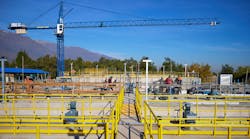A team of scientists is monitoring every stage of restoration at Emiquon, one of the largest American floodplain restoration projects. Their work recently got a boost from YSI, a maker of sensor-based instruments that detect water quality, which donated $20,000 worth of monitoring equipment to the Great Rivers Partnership and this wetland restoration project.
“Water quality issues affect all of us,” said Gayle Rominger, YSI senior vice president. “Increasingly, the governments and organizations of the world are placing a higher value on protecting and preserving water resources. That YSI is part of this revolution is really motivating, as we see our work applied in a very promising way.”
Water monitoring equipment is essential to restoration, as it provides a window into natural processes. Oxygen, for example, is needed for fish and invertebrates, while plants submerged in water need sunlight to grow. By monitoring dissolved oxygen in water and water clarity, scientists can determine whether plants and animals are getting what they need to thrive. By monitoring in real time, scientists have the opportunity to evaluate changes in the natural processes more quickly and act to protect the plants and animals if their survival is threatened.
Data from the equipment are continually broadcast to a web page that provides instant feedback about what is happening in the natural system. Wind direction and speed also are two variables scientists plan to monitor carefully, as winds can uproot tiny plants and stir up water. With this feedback, scientists can understand how the wind is moving across the land, enabling them to make management decisions, such as installing windbreaks or other protective measures.
“The data are there all the time; it's really amazing,” said Maria Lemke, an aquatic biologist. “This allows us to manage the restoration in real time, making decisions as the system changes.”
Students at University of Illinois at Springfield also will benefit from the new sensors. The school plans to access information being loaded onto the Web for online classes focused on floodplain conservation. Sharing data with project partners is one of the benefits of the equipment being integrated into networked, web-enabled monitoring systems.
As restoration advances, the sensors will be used to check on different aspects of the project. Scientists, for example, may use some of the ditches at Emiquon as nurseries for fish. If so, a monitor, strategically located in a ditch, would ensure oxygen levels fluctuate within normal ranges the fish require to survive. These data will be able to reveal whether too much algae are present in the system, which may exaggerate normal oxygen fluctuations to levels that are stressful to fish.
Source: Tracy Boutelle, The Nature Conservancy

